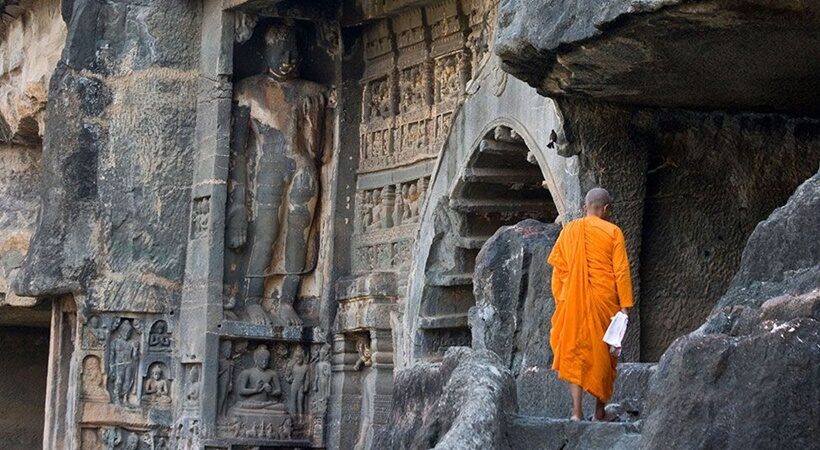Constructed over an 800-year period, the Ajanta Caves span a massive rock face in Maharashtra and are filled with ornate frescoes considered masterpieces of Buddhist art. Ajanta is split into two main series of caves, one built in 200 BCE and the other finished around 600 CE. Each cave opens up into grand halls, bedecked from floor to ceiling in the detailed depiction of the Jataka stories, which convey Buddha’s past life.
These caves are excavated in horse–shoe shaped bend of rock surface nearly 76 m in height overlooking a narrow stream known as Waghora. The location of this valley provided a calm and serene environment for the Buddhist monks, who retreated to these secluded places during the rainy seasons. This retreat also provided them with enough time for furthering their religious pursuits through intellectual discourses for a considerably longer period. The caves were excavated in different periods (circa. 2nd century B.C. to 6th century A.D.) according to the necessity. Each cave was connected to the stream by a flight of steps, which are now almost obliterated, albeit traces of some could be noticed in some places.

In all, a total of 30 excavations were hewn out of rock which also include an unfinished one. Out of these, five (cave no. 9, 10, 19, 26, and 29) are chaityagrihas and the rest are viharas. In date and style also, these caves can be divided into two broad groups. The earliest excavations belong to the Hinayana phase of Buddhism of which similar examples could also be seen at Bhaja, Kondane, Pitalkhora, Nasik, etc. These caves can be dated back to the pre-Christian era, the earliest among them being Cave 10 belonging to the second century B.C. The object of worship is a stupa here and these caves exhibit the imitation of wooden construction to the extent that the rafters and beams are also sculpted even though they are non-functional.

Image Credits: Wiki Commons
The world-famous paintings at Ajanta also fall into two broad phases. The earliest is noticed in the form of fragmentary specimens in caves 9 & 10, which are datable to the second century B.C. The headgear and other ornaments of the images in these paintings resemble the bas-relief sculpture of Sanchi and Bharhut.
The second phase of paintings started around the 5th – 6th centuries A.D. and continued for the next two centuries. The variation in style and execution among these paintings are quite noticeable, mainly due to the differences in the works of craftsmen. A decline in the execution can also be seen in some paintings as indicated by some rigid, mechanical and lifeless figures of Buddha in some later period paintings. The main theme of the paintings is the depiction of various Jataka stories, different incidents associated with the life of Buddha and contemporary events and social life.



















